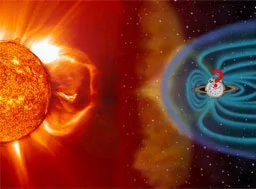The activity of a planetary magnetosphere (measured for example in terms of fluxes and energies of the accelerated charged particles) is directly related to its auroral activity (electromagnetic emissions - UV and low radio frequencies, in particular produced by these accelerated particles when they are driven towards the polar areas). The variations of the auroral activity, observable remotely, are thus a diagnosis of the global magnetospheric activity. Significant temporal variations are actually observed. They are attributed on the one hand to the modulation of the magnetospheric processes induced by the rotation of the planetary magnetic field (involving for example a precession of the magnetic axis), and on the other hand to the fluctuations of the solar wind (density, speed, pressure, direction and intensity of the interplanetary magnetic field) around the magnetospheric cavity. It is the relative contribution of these internal and external controls which will condition the magnetospheric activity. At first approximation, one can quantify the role of these two "engines" via the difference of potential induced through the magnetosphere by the electric field E = V X B induced by each of them. In the case of rotation, the velocity V is the corotation speed (Omega R) of the magnetospheric plasma and B the planetary magnetic field. In the case of the solar wind, V is the wind speed and B the interplanetary magnetic field. For Jupiter, one calculates that the electric field of corotation induces a difference of potential integrated on the magnetosphere radius (approximately 4 000 000 km) of 400 MegaVolts, while the solar wind convection induces a difference of potential of " only " 1 MegaVolt between the two sides of the magnetosphere. Rotation thus seems the dominating engine of the Jupiter magnetospheric dynamics. However the variations of many processes (electromagnetic emissions, spectra of energetic particles) suggest an influence of the solar wind much deeper than implied by the figures above.
Figure 1. Flux of hectometric radiation as a function of time, detected by the Cassini RPWS(Radio and Plasma Wave Science), and the Galileo PWS (Plasma Wave Science) during the Cassini approach to Jupiter. The flux is averaged over the 9h55 rotational period of Jupiter. Three events (A, B, C) are detected. A : days 324 - 330, B : days 343-351, C : days 354-358. Comparison with the solar wind magnetic field and plasma data from the Cassini magnetometer MAG, and plasma spectrometer CAPS show that event A was preceded by a strong interplanetary shock at 17h02 UT on day 323, event B was preceded by a strong shock at 23h12 UT on day 342 and C by a shock at 15h12 UT on day 354. The shocks A and B were subsequently detected by Galileo PWS at 09h15 UT on day 324 and 12h10 UT on day 343.
The measurements of a single probe in orbit (such as Galileo) do not in general answer the question of the relative influence of rotation and solar wind on the magnetosphere, because of the intrinsic space-time ambiguity of these measurements : is a variation observed due to the displacement of the satellite or does it globally affect the magnetosphere ? But at the end of 2000, the Cassini probe flew over Jupiter while Galileo carried out its observations in orbit. Cassini thus detected - via measurements of ionic density and magnetic field - the passage at a few days intervals of three shock waves in the solar wind (called " interplanetary shocks ", and propagating at 500-800 km/s). The instruments of the two probes then could measure an intensification of the radio and UV auroral activity of Jupiter, correlated with the impact of these shocks on the Jupiter magnetosphere.
Figure 2. Comparison for event A of solar wind magnetic field (MAG on Cassini) solar wind ion density (CAPS on Cassini) hectometric radiation (PWS on Galileo) and Extreme Ultra-Violet EUV auroral H2 band (110-113nm, by UVIS on Cassini). The arrows indicate the time the shock was detected by Cassini and Galileo.
A more quantitative study of the relative influence of rotation and solar wind on the Jupiter magnetosphere requires continuous global observations over a duration higher than that of the studied phenomena (several months), so as to dissociate the involved time-scales. Such observations could be the goal of a dedicated microsatellite.
Figure 3. Frequency-time diagram from Galileo PWS showing the radio intensities during event B. The time of interplanetary shock detected by Cassini is indicated by the arrow at top. The arrival of this shock to Jupiter is thought to correspond to trapped continuum radiation at 12h10 UT on day 343, which indicates a sudden compression of the magnetosphere. The color key at the bottom shows when the space craft is inside or outside the magnetosphere, based on the presence or absence of this continuum radiation. The onset of hectometric radiation is coincident with the compression.
Référence
- Gurnett D.A., Kurth W.S., Hospodarsky G.B., Persoon A.M., Zarka P., Lecacheux A., Bolton S.J., Desch M.D., Farrell W.M., Kaiser M.L., Ladreiter H-P., Rucker H.O., Galopeau P., Louarn P., Young D.T., Pryor W.R., Dougherty M.K. "The solar wind control of Jovian hectometric radiation and auroral EUV emissions" Nature, Thursday 28 Feb 2002 R. Prangé, P. Zarka, G. E. Ballester, T. A. Livengood, L. Denis, T. D. Carr, F. Reyes, S. J. Bame, and H. W. Moos "Correlated variations of UV and Radio emissions during an outstanding jovian auroral event" J. Geophys. Res. -Planets, 98, 18779-18791, 1993
Contact
- Philippe Zarka
Observatoire de Paris LESIA - Alain Lecacheux
Observatoire de Paris LESIA

